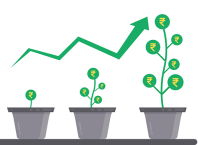Who wouldn’t want to sit back and let their computer take over and execute their trades on their behalf? However, most people feel confused by an automated trading system as it is hard to grasp at the first instance. Such confusion leaves them with the question in their minds: does anyone make money with algorithmic trading?
The simple answer is this – Yes, they do. However, the truth is that whether it is algorithmic or regular trading, you need to spend time and effort to understand the system before you start making money.
Contents [show]
Who is an Algorithmic Trader?
An algorithmic trader is a trader who relies on automated trading analysis for the execution of trades. They need to run the targeted script on their computers and allow the trade to get executed automatically. This leaves a trader with a lot of time on their hands to do other things as they don’t have to keep their eyes fixed on their screens as they do with conventional trading.
That doesn’t mean that algorithmic trading is free of human intervention. There is a lot of work that should be done, which is mostly research-oriented. Algo traders need not strain themselves too much analyzing markets and placing and executing orders. The research they do helps them find trading edges and take advantage in the markets and back testing their strategies to establish how robust they are before implementing. Even after all this, the algorithmic trader needs to monitor the system to ensure no hitches.
Algorithmic trading has an Edge
Once traders take to algorithmic trading, they realize that it is far superior to all other forms of trading. One good example is the freedom they get to deploy multiple strategies simultaneously. Trading 100 strategies in various markets, including day-trading or trading on long-term positions, is rendered very easy. Traders don’t have to be tied down with one style.
Researching the Trading Edges
The trick lies in researching and identifying the trading edges and developing unique strategies based on such edges. Sharp traders learn the ropes quickly and become adept at coding in the trading platform’s language to execute trades. They get their trading ideas from the intense research they conduct as also from their peers. Armed with this information, they do a bit of back testing to establish the merits within before executing trades. This is the benefit of using an automated trading system where losses are ruled out.
How do these Traders Make Money?
An algorithmic trading system helps a trader develop several trading strategies that are robust and fail-proof. The trader still has to decide when the system should execute a trade and write appropriate commands based on the research pointing to the edge in the market. These rules would have worked in the past, and historical research findings are part of the strategy of an automated trading system that pulls up the historical data.
Algorithmic trading systems are based on a trading strategy developed from research on past performance that generated profits. The traders realize that whatever works or doesn’t work is not based on intuition or common sense but on extensive research that helped identify the edge. Most of the losses in trading have occurred due to unscientific trading strategies based on hunches.
In a nutshell, algorithmic traders make money because of:
- Intense research involves the study of several markets and identifying the edges. Instead of conducting a random search, traders research trading ideas from financial journals that feature the theories published by knowledgeable academics.
- The traders develop their strategy based on the ideas they have researched and modify the ideas to build a winning strategy.
- Once they’ve settled on the scrip to trade, they back test based on historical price data to check how those strategies would have worked out in the past. Most automated trading systems feature advanced strategy testers, and back testing helps them decide the next step – whether to adopt the strategy, modify it, or abandon it.
- Forward testing is testing strategies that have performed excellently (according to available historical data) in the real-time market. Forward testing indicates whether this strategy will work in a live market.
- System implementation is based on proven strategies that will perform well to execute trades. However, the strategies need monitoring to ensure they perform as expected.
Traders use several trading strategy categories, including:
- Mean Reversion
- Following Trends
- Biased Strategies
The mean reversion strategy relies on the theory that prices always swing above and below the long-term average. However, the price tends to settle back to the original level after any significant fluctuation. A short trade opportunity presents itself when the price moves above the average, and a long trade opportunity is evident when the price moves below the average.
Biased strategies are more specific to individual markets and would largely depend on market behavior at that particular time.
Summing it Up
The amount of profit that traders make from algorithmic trading varies according to the market conditions. It is mostly dependent on the strategies being adopted and the funds being allocated. Well-research strategies are bound to fetch higher profits.












